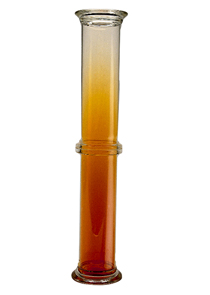DK Science: Non Metal Elements
The metal elements in the periodic table have easily defined properties. The remaining elements, however, have very different properties. They consist of a group of unreactive gases called the NOBLE GASES, a group of reactive elements known as the HALOGENS, and a set of elements referred to as non-metals. In addition, a few elements have properties that place them in between metals and non-metals. They are called the SEMI-METALS.
Deposits of the non-metal sulphur are found as deep as 300 m (1,000 ft) below ground. Combined with other elements, sulphur is also found in rocks and minerals, such as gypsum.
Sulphur crystals are ground to a powder at sulphur processing plants. The powder is sprayed into a furnace where it reacts with oxygen, forming sulphur dioxide. More oxygen is reacted with the sulphur dioxide to make sulphur trioxide, which is dissolved in water to make oleum.
Oleum is concentrated sulphuric acid. It is transported to manufacturing plants in tankers. Here, water is added to the oleum in precise measures to make the correct concentration of sulphuric acid. Sulphuric acid is used in the manufacture of detergents, paints, medicines, plastics, and synthetic fabrics.
The elements known as semi-metals have some of the properties of metals and some of the properties of non-metals. Arsenic, for example, has the shininess of a metal but does not conduct heat or electricity very well. Other semi-metals, such as silicon and germanium, are semi-conductors. This means that they can conduct electricity, but only under special conditions. This property makes them very useful in solar panels and computers.
At first sight, the halogens don’t seem very alike. For example, fluorine is a yellow gas and iodine is a shiny, black solid. However, they are all highly reactive and are quick to combine with other elements to form salts, such as table salt (sodium chloride). They also have important uses. Chlorine is used to disinfect water, and compounds of fluorine – fluorides – are added to toothpaste to prevent tooth decay.

Bromine is the only liquid non-metal element. It is a reddish-brown colour and evaporates quickly to form a choking, poisonous gas. Bromine is found in seawater and mineral springs in the form of salts, called bromides. Bromine compounds are used in photography, as mild sedatives, and in the manufacture of flameproof coatings and dyes.
In X-ray photography, a plastic film is coated with a paste of a bromine compound called silver bromide. When X-ray light strikes the film, the silver bromide breaks apart and pure silver atoms are left on the film. The more intense the light, the more silver atoms are formed and the darker that part of the image becomes.
Group 18 of the periodic table contains the noble gases. These six unreactive gases do not combine with other elements, so they are usually found on their own. Nearly 1 per cent of air is argon. Traces of neon, helium, krypton, radon, and xenon are also found in air. Argon is used in light bulbs, xenon is used in lighthouse arc lamps, and helium is used to fill airships and hot-air balloons.
A neon light is a tube containing a noble gas, but not always neon. When electricity is passed through the tube, the atoms of the noble gas emit (give out) light of different colours. Helium emits a yellow light, neon a red light, argon a blue light, and krypton a purple light. Other colours are created by giving the glass tube different coloured coatings.
